Exploring the Diverse Uses of Fake Ivy Leaves in Design
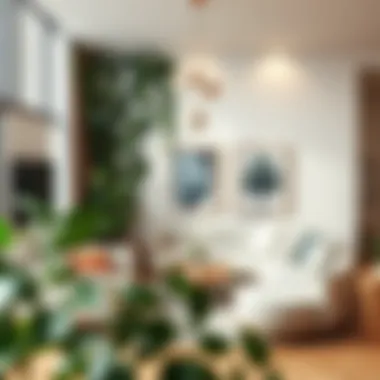
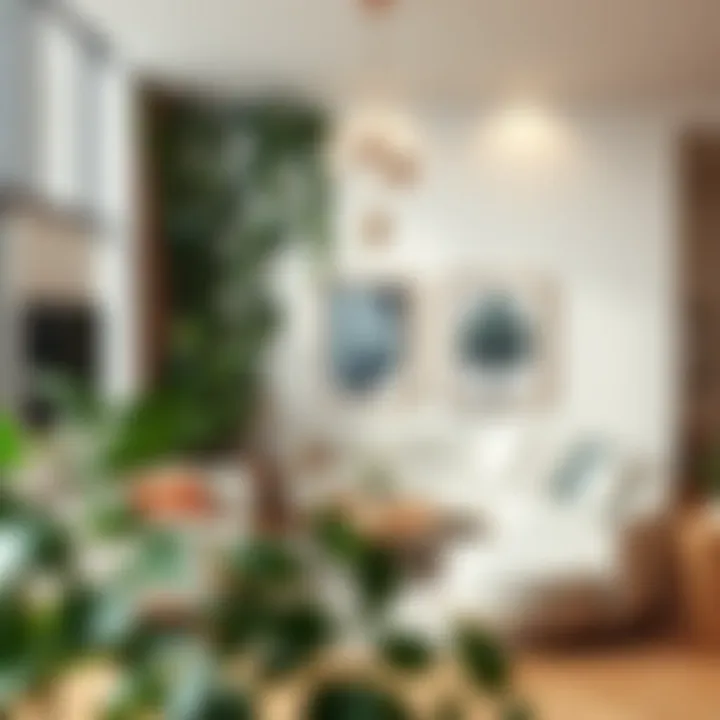
Intro
In today’s ever-evolving design landscape, where creativity often blends with practicality, artificial elements hold significant sway. Fake ivy leaves, in particular, have found a special place both in the hearts and homes of many. These vines are not simply embellishments; they embody the intersection of style, functionality, and an emerging narrative surrounding sustainability. Far from being mere decorative pieces, they serve multiple purposes across various domains, from indoor aesthetics to fashion accessories.
As we dive deeper into this topic, various elements come into play. Recent trends highlight the growing reliance on faux greenery, which allows people to introduce natural beauty without the challenges—like upkeep and seasonal limitations—associated with real plants. Not only do these leaves add a touch of nature to design spaces, they also resonate with eco-conscious values, shifting the focus towards sustainability.
\nWith such diverse applications, it becomes essential to explore how fake ivy shapes both personal style and broader design concepts. This piece aims to provide a thorough overview of these artificial beauties—celebrating their aesthetic appeal and practical uses, while addressing their importance in contemporary discourse on design.
Preface to Fake Ivy Leaves
In contemporary design, fake ivy leaves have carved out a niche for themselves. They bring a slice of nature indoors, transforming spaces without the upkeep that live plants require. Understanding the versatility of these artificial greens is vital for designers, stylists, and retailers. These leaves are more than just decorative pieces; they serve various aesthetic and functional roles that cater to diverse environments and preferences.
Fake ivy leaves offer multiple benefits. Primarily, they are a low-maintenance alternative to live foliage, with no need for watering, sunlight, or soil, making them an ideal choice for even the busiest urban dwellers. Additionally, these leaves can easily be styled in ways that complement any theme – from rustic to modern chic. Considerations about their materials, textures, and colors reveal a vast array of options, aligning with trends that prioritize sustainability and accessibility.
Historical Context
The use of artificial greenery is not a new phenomenon. Fake plants emerged in the mid-20th century as a response to the growing demand for indoor decor without the hassle of tending to natural plants. Early iterations of fake ivy lacked realism, often appearing overly shiny or stiff, yet they satisfied a need at the time.
As technology improved, so too did the craftsmanship behind faux plants. Innovations in materials have allowed for a more lifelike appearance, making them a preferred choice for many interior designers today.
From their curious beginnings, these artificial leaves have evolved significantly. They now reflect designs that feel both vibrant and organic, blending seamlessly into various environments.
Current Trends in Use
In today’s design landscape, the tide has turned, with fake ivy leaves popping up everywhere. Styling these leaves to create shelf decor or framing a mirror with them can add a dramatic flair. Their adaptability knows no bounds, fitting neatly into commercial spaces, homes, and events.
Let’s take a closer look at some notable trends:
- Eco-Friendly Decor: With a heightened awareness of environmental issues, fake ivy leaves are often chosen as a sustainable alternative to fresh plants.
- Mixed Media Designs: Designers frequently use faux ivy alongside other materials, like wood and metals, to create an intriguing contrast that captivates the eye.
- Event Themes: From weddings to corporate functions, the incorporation of artificial greens lends a lush illusion without the need for continuous care.
More than just ornamental, fake ivy leaves represent a fusion of style, practicality, and innovation. Their ongoing evolution continues to pique interest across the design spectrum, making them an essential component for those who are conscientious about aesthetics and sustainability.
Aesthetic Appeal of Fake Ivy Leaves
The use of fake ivy leaves has become increasingly popular in contemporary design, and the aesthetic appeal is one of the primary factors behind this trend. Artificial ivy offers an array of benefits, from versatility in color and texture to its ability to create various atmospheres without the need for upkeep. Simply put, incorporating these leaves into different spaces can easily add life, vibrancy, and interest to otherwise muted or plain settings.
Color Variations and Textures
Fake ivy leaves come in a surprising variety of colors and textures, making them an ideal option for a multitude of design schemes. While the classic green variants are the most recognizable, they can also be found in shades of purple, variegated patterns, and more. This palette allows designers to play with color theory and mood setting in interiors or events. For instance, a deep green can evoke feelings of tranquility, while a lively yellowish-green can inject energy into a room.
Textures are equally important; today’s artificial leaves are crafted to mimic the slight irregularities found in nature. Some may feature a glossy finish, while others resemble soft matte textures. Each type contributes to the overall ambiance, whether one is aiming for a rustic charm or modern sleekness. Furthermore, the interplay of light with these textures is critical. When strategically placed in a room, fake ivy can catch light and reflect it in ways that breathe life into dull corners.
- Adaptability: Colorful ivy can blend seamlessly into a wide array of environments, from cozy cafes to chic boutiques.
- Layering: Mix and match different textures for a more dynamic visual presentation.
Realism vs. Artificiality
The tension between realism and artificiality in design has been an ongoing debate, and fake ivy leaves serve as a case study in this discussion. Whereas some purists argue for the authenticity of live plants, others see merit in the convenience and adaptability of faux foliage. The key is balance.
In designs where natural motifs play a role, the realism of fake ivy can often pass muster next to real plants. High-quality artificial ivy leaves can be so lifelike that one may have to double-check to determine whether they are real or not. Yet, designers must be aware of the risk of pursuing an overly artificial aesthetic. Incorporating a healthy amount of greenery allows for the softness that comes from organic materials without overwhelming the space with maintenance needs.
"The right kind of artificial plants can bring the comfort of nature indoors while keeping it practical for daily life."
Ultimately, striking the right note between the realistic qualities of plants and the convenience of artificial counterparts can create a compelling design narrative. The commitment to quality and aesthetics in the choice of fake ivy leaves translates into a statement piece that serves both form and function, making it a wise option for savvy stylists, fashion designers, and retailers.
Functional Uses of Fake Ivy Leaves
Fake ivy leaves are more than just decorative elements; they play integral roles in various functional applications. Their versatility makes them a staple in both everyday home decor and larger scale events. As the demand for low-maintenance yet aesthetically pleasing design elements rises, the appeal of fake ivy becomes even more evident.
Home Decor
Wall Coverings
When it comes to wall coverings, fake ivy leaves serve as a unique solution to bring life into previously bland spaces. Instead of the traditional wallpaper, draping these faux greens can create an inviting, vibrant atmosphere without the hassle of upkeep. One standout characteristic of wall coverings adorned with fake ivy is the texture they add. The organic feel contrasts sharply with modern materials, giving spaces a cozy yet stylish ambiance.
The unique feature of ivy wall coverings lies in their flexibility— they can be arranged in a myriad of ways. Homeowners can choose to cover entire walls or craft intricate designs. One downside could be the potential for dust accumulation, which requires infrequent cleaning, but it's a small price to pay for such an alluring visual impact.
Table Centerpieces
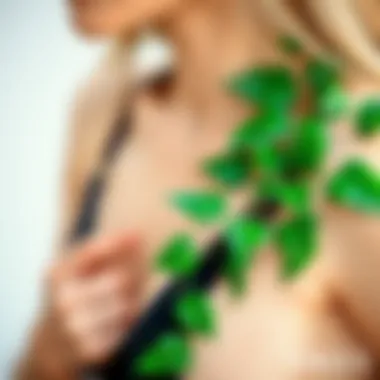
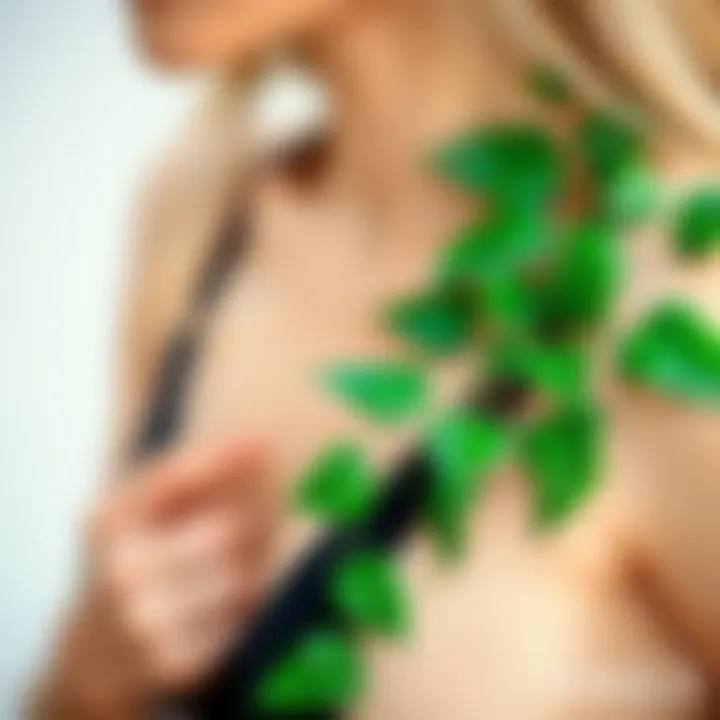
Table centerpieces featuring fake ivy leaves have become increasingly popular for their ability to blend elegance with simplicity. In these arrangements, the key characteristic is their adaptability. From casual gatherings to sophisticated dinners, faux ivy adds a touch of greenery that can be dressed up or down.
The beauty of using fake ivy here is that it allows for creativity in design. Centerpieces can range from lavish displays to understated arrangements. An advantage is longevity—unlike fresh flowers, these arrangements won't wilt and are ready for any occasion at a moment's notice. However, some might argue that they lack the fragrance that real flowers possess, which can be a point of contention for traditionalists.
Indoor Gardens
Indoor gardens featuring fake ivy leaves can transform even the smallest spaces. This option offers an escape into nature, irrespective of the external environment. The key characteristic lies in the illusion they create— rooms can appear larger and more open when adorned with these lifelike pieces. They’re especially beneficial for those without a green thumb, as they require zero maintenance.
A unique feature of indoor gardens crafted with fake ivy is their versatility in arrangement. They can be combined with other faux plants or placed in unique pots to enhance the overall design. Though purists might miss the experience of nurturing real plants, the ease and continual vibrancy of fake ivy cannot be overstated.
Event Decorations
Weddings
Weddings adorned with fake ivy leaves can evoke romance while maintaining practicality. One significant aspect is their ability to transform venues into lush, enchanting spaces at a fraction of the cost of fresh flowers. The popularity of this approach is underscored by its flexibility in styling—from rustic themes to glamorous settings.
A standout feature of fake ivy in weddings is its durability. These decorations can be reused, allowing couples to have beautiful setups without the excessive costs tied to traditional florals. However, some may believe that artificial elements might lack the charm associated with fresh blooms, leading to mixed feelings among purists.
Corporate Events
Incorporating fake ivy leaves into corporate events brings a touch of warmth to otherwise sterile environments. The key characteristic here is their professional appeal. They contribute to a welcoming atmosphere, making events feel less formal and more engaging.
A unique feature of using fake ivy in corporate settings is the ease of customization. Companies can create branded displays or centerpieces that reflect their identity. One disadvantage could be the potential disconnect some guests may feel due to the artificial nature, but overall, the versatile designs often outweigh this consideration.
Seasonal Celebrations
Seasonal celebrations often embrace fake ivy leaves for their ability to complement various themes. During fall, for example, they can be mixed with warm-toned decorations for a cozy feel. The key characteristic is their adaptability to seasonal changes.
One particular advantage is that they can be stored and reused year after year, making them a cost-efficient alternative. Nonetheless, some consumers might still prefer seasonal flowers that confer traditional aromas and textures related to specific celebrations.
Sustainability Narratives
The use of fake ivy leaves within modern design isn't just a matter of aesthetics or fashion; it's also deeply tied to sustainability. This section discusses key aspects of sustainability narratives that resonate with the contemporary design industry, showing how these artificial elements contribute positively to environmental conversations. As consumers become increasingly environmentally conscious, the demand for sustainable decor options has risen significantly. Fake ivy leaves serve as a practical solution that addresses these concerns while maintaining an appealing look.
Reducing Waste in Decor
In today's world, where environmental impact is a pressing concern, fake ivy leaves present an innovative method for reducing waste in decor. The truth is, opting for artificial alternatives drastically lessens the need for constant replacement of fresh plants, which tend to wilt and die over time. Not only does this save consumers money, but it also reduces the carbon footprint associated with growing, transporting, and disposing of real greenery.
- Longevity: One of the main advantages of fake ivy leaves is their durability. Unlike fresh plants that require regular maintenance, artificial ivy doesn't perish and can beautify spaces for years. This long-term usage exemplifies a move towards less waste in decorating settings.
- Resource Utilization: Fresh plants frequently demand extensive resources for growth, including water and nutrients, often leading to environmental depletion. By using fake ivy, one can simultaneously beautify their space while minimizing resource consumption, supporting sustainable practices. This method sends a clear message: style can coexist with environmental mindfulness.
"Using artificial plants doesn't mean sacrificing beauty; it means rethinking how we define sustainability in decor."
Alternative to Fresh Greens
By utilizing fake ivy leaves as a substitute, consumers have a chance to incorporate the vibrancy of nature into their designs without the downsides associated with live plants. Fresh greens, while often delightful to the eye, come with challenges that many find tiresome.
- Maintenance-Free: One of the great appeals of fake ivy is the zero-maintenance promise. No watering, no pruning, and no dead leaves cluttering spaces. This attribute makes it ideal for busy lifestyles or settings where maintaining live plants may not be feasible, such as corporate offices or areas with limited natural light.
- Allergy-Friendly: Fresh plants can often be problematic for people with allergies, leading to discomfort and health issues. Fake ivy sidesteps this dilemma, allowing individuals to enjoy the aesthetic benefits of greenery without the irritations that real plants might engender. This highlights how alternative solutions can contribute to a welcoming atmosphere for everyone.
Comparative Study: Fake vs. Real Ivy
When it comes to interior design and decor, the choice between fake and real ivy often arises as a critical point of discussion. This section dives into the nuanced differences between the two, helping consumers make informed decisions about their greenery needs. Both options have their own set of perks and pitfalls, and understanding them is key to embracing the versatility of ivy leaves in design.
Cost-Benefit Analysis
On the surface, the price tag is often one of the most compelling factors in the fake versus real debate. Real ivy, while initially appearing to be the more "authentic" choice, typically requires a greater investment in ongoing maintenance. For instance:
- The cost for purchasing real ivy can vary based on species and place of purchase, but once you have it, you’ll need to continually invest in soil, pots, and plant food.
- Additionally, consider the water bills that come along with keeping those plants alive—especially during the hotter months when they require more water.
In contrast, fake ivy leaves are often a one-and-done purchase. While the initial cost may vary depending on quality and brand—such as those offered by Nearly Natural or Silk Plants Direct—they excel in longevity. These decorative leaves can last for years with minimal upkeep.
A quick comparison between expenses:
- Real Ivy: Initial costs for plants + soil + pots + fertilizers + water + time.
- Fake Ivy: Initial purchase cost + occasional dusting/cleaning.
In many cases, fake ivy emerges as the stronger economic choice in the long run, particularly for busy households or commercial environments where low maintenance is vital.
Maintenance Requirements
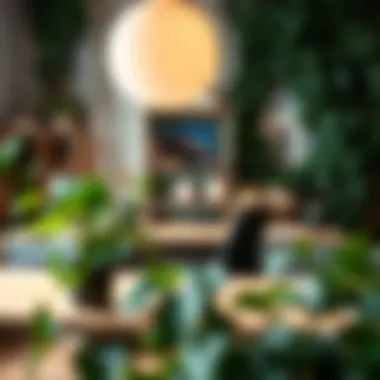

Maintenance is another pivotal point in the fake vs. real ivy discussion. Real ivy demands care that can be both time-consuming and, at times, tricky.
- Watering: Real ivy prefers a balanced watering schedule; too much or too little can spell doom.
- Pruning: To prevent overgrowth and ensure the vine retains its charm, regular pruning is essential. This requires a certain level of plant knowledge.
- Pests: When you welcome real plants into your home, you might inadvertently invite unwelcome guests like aphids or spider mites. Monitoring and treating pests can add another layer of complexity.
In contrast, fake ivy offers almost a carefree experience. You simply have to dust off the leaves now and then, which makes it an attractive option in busy settings, like cafes or offices where aesthetics matter, but time is minimal. The ability to place fake ivy in spaces lacking sunlight is another boon.
Importantly, the absence of allergens with artificial plants makes them suitable for individuals with allergies, allowing broader applications in homes or public spaces.
Effective in lowering stress levels and enhancing mental well-being, incorporating plants—real or fake—is a stylish choice for a calming environment.
Ultimately, choosing between fake and real ivy can lead to varied experiences in terms of cost, maintenance, and versatility. While real ivy offers an organic feel, fake ivy shines in its convenience, durability, and broad applicability. Each individual or business must weigh these factors against their unique requirements.
Cultural Perceptions of Fake Ivy
Understanding the cultural perceptions of fake ivy is critical in analyzing its applications in design. Fake ivy leaves are not merely ornamental; they carry layers of meaning that vary across different societies. Their reception can greatly influence design choices, whether for personal spaces or commercial endeavors. Over time, fake ivy has transitioned from being seen merely as an alternative to real plants to becoming an aesthetic choice that reflects changing values and trends.
Symbolism in Different Cultures
In many cultures, ivy symbolizes fidelity and eternity. For instance, in ancient Greece, ivy was entwined in the crowns of Bacchus, the god of wine, often representing perseverance and victory. This symbol of strength connects with how fake ivy is utilized in contemporary design. Designers leverage these historical meanings to evoke specific feelings and nuances in their works.
Consider the use of fake ivy in wedding decor. It’s laden with symbolism, promoting ideas of eternal love and commitment. Couples choose fake ivy for their floral arrangements, finding it practical yet meaningful. As the leaves don’t wilt or fade, they serve as a perpetual reminder of their vows. The choice of faux foliage reflects both an appreciation of nature and acknowledgment of practicality in planning.
Here are a few symbolic interpretations in nuanced cultural contexts:
- Western Cultures: Ivy reflects fidelity and strong relationships.
- Chinese Culture: Ivy is nod to growth and connection, often associated with family.
- Japanese Culture: Commonly seen as a symbol of unchanging love and affection.
This broad range of significances showcases how design can be influenced not just by the physical attributes of fake ivy, but also by the meanings imbued within it by various cultures.
Stigmas and Misconceptions
Despite its numerous benefits, fake ivy still battles certain stigmas and misconceptions. There is an underlying belief that using artificial plants signals a lack of care for the environment or a refusal to engage with the natural world. This viewpoint may dissuade some from incorporating fake ivy into their designs, particularly in eco-conscious communities.
However, this perspective overlooks the innovative strides within the production of artificial greens. Many companies are now focused on sustainability, creating products that utilize recycled or eco-friendly materials. The narrative has shifted from simply 'fake' to a mindful and practical choice in decor. Here are some common misconceptions:
- Fake Ivy Is Low Quality: Many assume that all artificial plants look cheap, yet top-tier products replicate true-to-life textures and colors.
- Using Fake Ivy Is Lazy: Some view the use of artificial plants as a shortcut, arguing that it demonstrates a lack of commitment to maintaining real foliage.
- Environmental Impacts: There's a belief that using fake ivy contributes to plastic waste; however, this is being addressed by sustainable production methods and longer product lifespans.
As these misunderstandings begin to dissipate, more designers and consumers are realizing the potential of fake ivy. Those in fashion and retail are increasingly adopting it, not just as a decorative piece but as an interesting layer within their brand narratives.
"Design is the silent ambassador of your brand."
From its varied symbolism across cultures to the misconceptions that surround its use, the cultural perceptions of fake ivy leaves add rich context to their role in contemporary design. The embrace of fake ivy reveals an evolution in societal values toward a blend of aesthetics, practical choices, and deeper meanings.
Creative Applications in Fashion
The application of fake ivy leaves in the fashion sector serves a dual purpose—decorative and functional. In today’s world, where sustainability and creativity intertwine, such elements embody a fresh perspective on how we integrate nature into our daily lives. Using fake ivy leaves in fashion is not just a trend; it’s becoming a popular choice for forward-thinking designers who seek to express a connection with the outdoors while maintaining the convenience of synthetic materials.
Accessories and Jewelry
In recent seasons, accessories embellished with fake ivy leaves have surged in popularity. From earrings that mimic cascading vines to intricate necklaces featuring stylized ivy, these designs often resonate with the wearer’s desire to showcase personal style while embracing nature-related themes. The beauty of mink and faux leather gently combines with these faux leaves, resulting in striking pieces that tell a story.
Such accessories tend to appeal to different demographics, crossing age and style barriers. For example, a dainty pair of ivy leaf studs can elevate a casual outfit, while bold statement pieces—like chunky bracelets adorned with ivy—can be the highlight of a more formal ensemble. The versatility of the material also means that it can be dyed to match various color palettes, allowing designers to cater to a broad spectrum of tastes.
- Benefits of Ivy-Inspired Accessories:
- Eco-friendly alternatives that reduce reliance on natural materials
- Durability against wear and tear, unlike fresh foliage
- Light weight, making them easy to wear for long periods
In addition, the tactile experience of soft synthetic material emulating ivy can add something genuinely unique to jewelry design. A distinct piece can serve as a conversation starter. Most importantly, ethical considerations are becoming increasingly relevant in modern fashion, and using artificial components allows brands to resonate with environmentally conscious consumers.
Textile Patterns
Fashion designers have begun to incorporate prints inspired by ivy leaves into their fabric collections. Using digital printing methods, artists can create detailed patterns that replicate the natural beauty of ivy, yielding a textile that feels both inspirational and contemporary.
Such prints can be found in various types of clothing—from casual shirts to elegant dresses and everything in between. This approach not only beautifies garments but also aligns with the eco-conscious movement, providing alternatives to traditional patterns and prints created from more conventional materials.
The way fabrics behave enhances the overall appeal of ivy motifs. Lightweight materials drape and flow gracefully, evoking the movement seen in actual ivy plants. Meanwhile, stiffer textiles provide structured looks, creating a balance between organic shapes and tailored fashion.
Some potential considerations when working with ivy-patterned fabrics include:
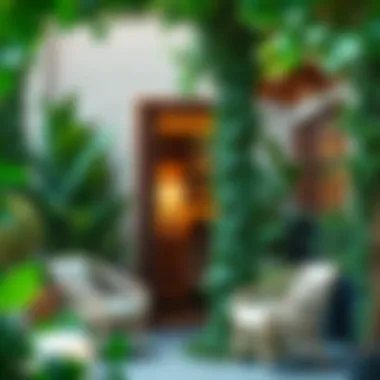
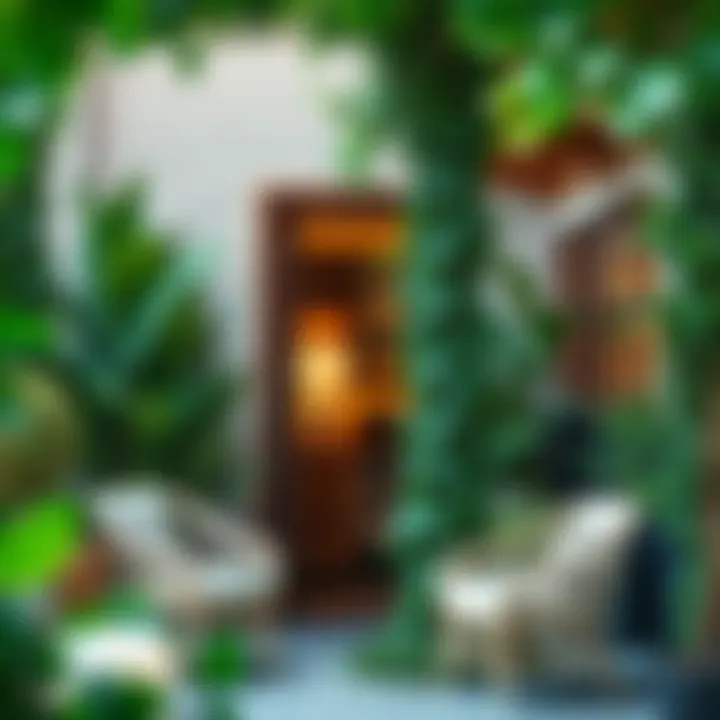
- Color Variations: Designs can be created using vibrant hues or subdued tones to match seasonal trends.
- Pairing Styles: Ivy prints can easily pair with solid colors, creating an eye-catching ensemble that doesn’t overwhelm.
- Cultural Reflections: This motif can resonate with different cultural aesthetics, ranging from bohemian artistry to modern minimalism.
Fashion transcends mere clothing; it’s an expression of identity and creativity. Fake ivy leaves present a unique opportunity for designers to fuse nature’s artistry with innovative design techniques, bringing us closer to the world around us—without forgoing style.
In summation, the use of fake ivy leaves in fashion represents a contemporary fusion of design, sustainability, and aesthetics. As this trend evolves, both designers and consumers can rely on synthetic alternatives to redefine style without compromising their ecological values.
DIY Projects Using Fake Ivy Leaves
Engaging in DIY projects using fake ivy leaves offers a creative outlet that blends artistry with practicality. In today's context, where sustainability and personalization are key, these projects not only beautify living spaces but also allow individuals to express their unique style. Fake ivy leaves – lightweight, easy to work with, and available in various shades and textures – present countless opportunities for transformation without the constraints associated with real plants. It is crucial to note that the benefits extend beyond aesthetics. Crafting allows for a customized approach tailored to specific tastes and settings.
Crafting Wall Art
Creating wall art with fake ivy leaves transcends mere decoration; it becomes a statement piece in any room. By utilizing these leaves, individuals can craft pieces that range from elegant and subdued to bold and colorful, depending on the vision and environment.
- Simple Techniques: Start with a base such as a canvass or wooden board. Glue the ivy leaves in an artistic arrangement, perhaps forming a pattern or even a heart shape. This not only makes for a stunning visual but also integrates a touch of nature into your space without maintenance worries.
- Framed Displays: Another fascinating method involves framing sections of ivy leaves, either preserved in a frame or arranged in a shadow box. The dimensional quality adds an intriguing layer, drawing the eye while breaking the monotony of flat surfaces.
- Color Coordination: For a modern take, consider spray painting the ivy leaves in metallic hues or contrasting colors. This not only highlights the leaves' textures but also ensures they complement the color scheme of the room.
In crafting wall art, the possibilities are nearly endless, allowing for the collaboration of various materials like twine, paint, and decorative stones. The result often inspires conversations and enhances the overall atmosphere of a space.
Creating Home Accents
Fake ivy leaves can serve as fantastic elements in creating home accents, merging function and flair seamlessly in various forms. These decorative pieces can filter throughout the space in creative, unexpected ways.
- Vases and Planters: One of the simplest methods of incorporating ivy leaves is by placing them in vases. Instead of traditional flowers, arrangements of ivy provide a verdant feel. Use a mix of leaves at different lengths for a natural cascade effect.
- Table Arrangements: Think of intertwined ivy leaves for table runners or centerpieces. A winding row of ivy can frame candle holders or add character during festive gatherings. By simply placing the leaves strategically, they can elevate the dining experience and enhance the ambiance.
- Seasonal Decor: Fake ivy leaves can morph to fit the theme of any season. For instance, mixing in pine cones and fake snow during winter months or bright colored florals in spring. This adaptability means that your home can continually evolve, staying fresh and engaging throughout the year.
As you delve into these projects, consider sourcing ivy leaves that reflect your personal style or the aesthetic of your space. It's also worthwhile to explore social media platforms or design forums to gather inspiration and ideas from fellow DIY enthusiasts to ensure your creations are as unique and striking as possible.
Embracing DIY projects with fake ivy leaves allows for joyful expression that breathes new life into one’s environment, all while being mindful of sustainability and personal taste.
Incorporating Fake Ivy into Minimalist Design
In the realm of contemporary interior decor, minimalist design is not just a trend; it's a lifestyle choice rooted in simplicity and functionality. By choosing to incorporate fake ivy leaves, designers can achieve a harmony between nature and minimalism without overwhelming spaces. These faux plants serve as a clever bridge, merging greenery into settings that often prioritize clean lines and an uncluttered aesthetic.
Balancing Nature with Minimalism
The philosophy behind minimalism emphasizes the idea of ‘less is more.’ Integrating fake ivy aligns perfectly with this principle. The goal is to select decor that provides aesthetic value while remaining unobtrusive. Fake ivy, with its delicate vines and varied hues, offers a splash of color without dominating the visual field. Whether placed in a corner vase or draping casually over a shelf, these artificial leaves contribute to a space's tranquility by echoing outdoor elements in a subtle manner.
Consider the following benefits of incorporating fake ivy:
- Year-Round Aesthetic: Unlike live plants, which require sunlight and attention, fake ivy stays green and vibrant throughout the seasons, ensuring continuity in your decor.
- Ease of Maintenance: A quick dusting is all it takes to keep these leaves looking their best, as opposed to the constant upkeep real plants demand.
- Space Efficiency: Perfect for tight quarters, such as a small apartment, fake ivy adds life without consuming precious floor space.
In minimalist settings, where every item holds significance, the inclusion of fake ivy can soften harsh lines and bring warmth, all while remaining understated.
Subtle Usage in Decor
Subtlety is key in minimalist designs, and fake ivy can be artfully incorporated without overshadowing other elements. For example, a singular vine might elegantly twist around a sleek lamp stand, or a modest cluster of leaves might find its place atop a coffee table book. The idea is not to make a grand statement but to allow these pieces to quietly enhance the existing decor.
When using fake ivy in minimalist spaces, consider:
- Color Coordination: Selecting shades that complement your overall palette can strategically emphasize your decor choices. Soft greens offer a refreshing contrast to muted tones.
- Scale and Proportion: Choose ivy arrangements that harmonize with your furnishings. Oversized displays might clash in compact rooms, while tiny accents can be lost in larger spaces.
- Layering with Textures: Pairing fake ivy with various materials, like ceramic pots or metallic accents, can add depth while remaining true to a minimalist vibe.
In summary, fake ivy leaves provide an elegant solution for those navigating the delicate balance of minimalism and nature. Their versatility and adaptability ensure they can enrich any contemporary design scheme, creating not just a room, but an environment that feels alive.
Future of Fake Ivy in Design
The future of fake ivy in design intertwines technology with the artistic expression of contemporary decor. As trends evolve, the need for elements that resonate with both aesthetics and practicality drives innovation. This section elaborates on the pivotal role fake ivy plays in modern design, encompassing the latest technological advancements and shifting consumer preferences.
Technological Innovations
In the realm of artificial decor, technological innovations open the door to a new world of creativity. For instance, advances in manufacturing techniques enable the production of fake ivy leaves that closely mimic the look and feel of their living counterparts. These innovations range from the development of textured surfaces that replicate the natural feel of ivy leaves to methods that enhance durability and color retention.
Another noteworthy advancement relates to eco-friendly materials. Brands are now investing in sustainable plastics crafted through recycling processes, which not only reduce waste but also present an environmentally-conscious option for discerning consumers. The capability to combine design with sustainability plays a significant role in making fake ivy a sought-after element in interiors.
Furthermore, the integration of technology in design applications, like augmented reality, allows customers to visualize how fake ivy can transform their spaces before making a purchase. This technology provides an immersive experience, aligning perfectly with the modern customer's desire for interactive and personalized shopping.
Evolving Consumer Preferences
As times change, so do the tastes of the clientele. Today’s consumers are more aware of their choices and their impact on the environment. This attitude influences their inclination towards items like fake ivy leaves. People increasingly seek options that offer low maintenance without sacrificing style.
Fake ivy addresses these concerns head-on. As it requires no watering, does not wilt, and stays vibrant, it has become a practical choice for both homeowners and businesses. On the fashion front, consumers are leaning towards accessories that not only express their identity but also reflect their values.
"Art should comfort the disturbed and disturb the comfortable." – Banksy
Buying fake ivy for interior design or personal adornment is being seen as a mindful decision as well. Thus, purchasing these items aligns with current consumer values, making them a staple in both fashion and home decor.







